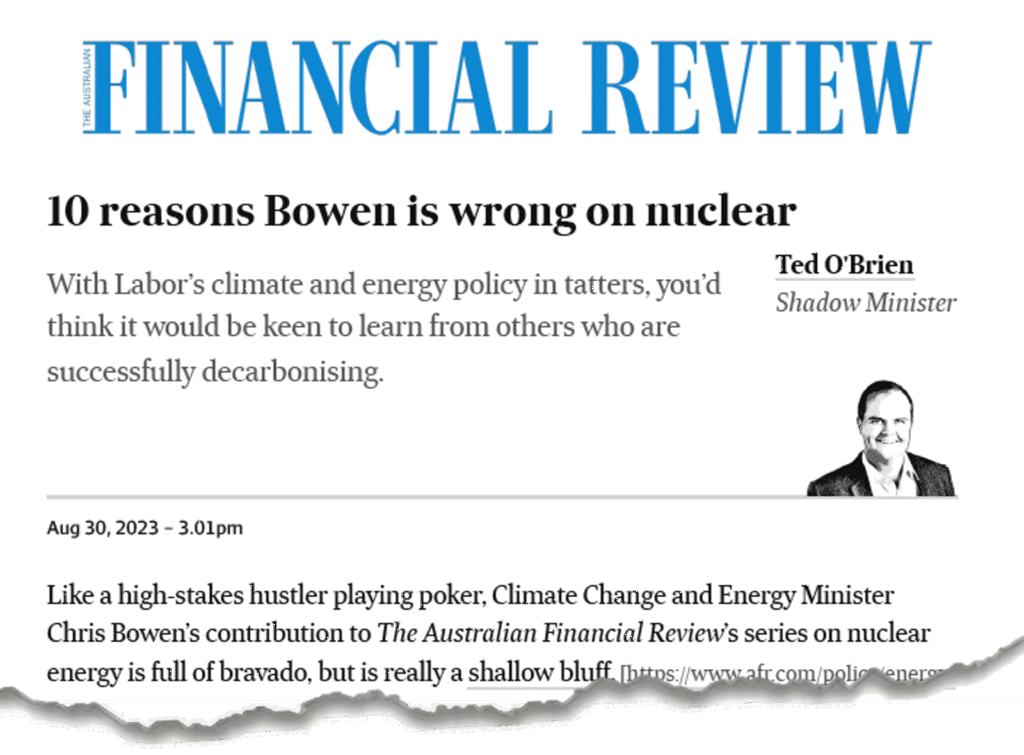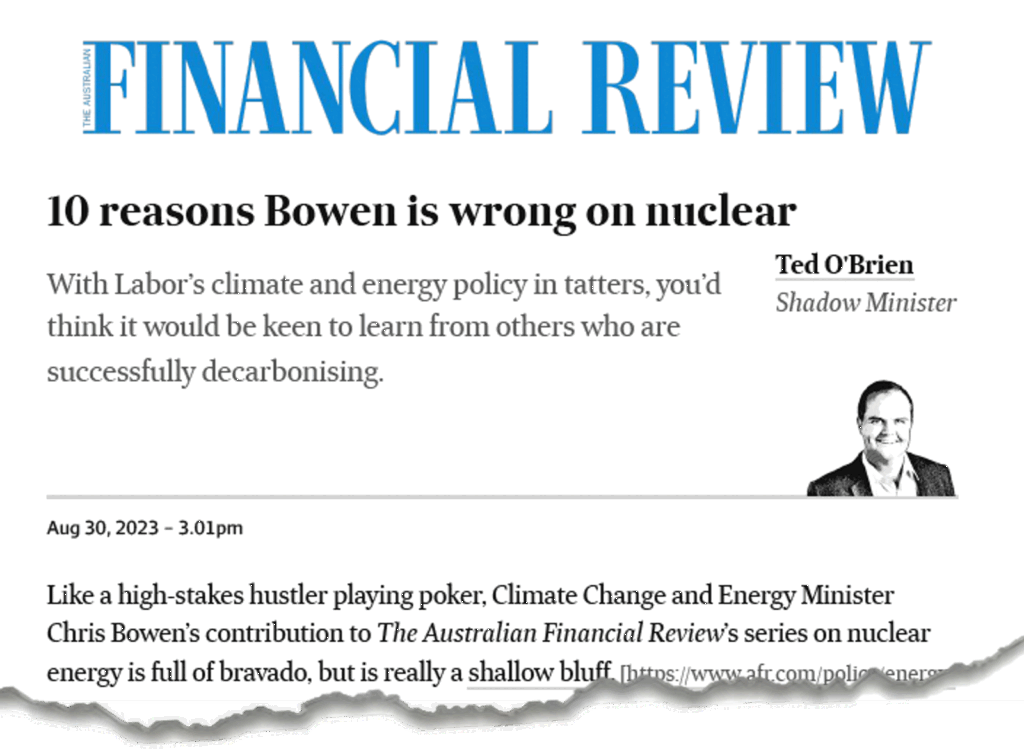As published in the Australian Financial Review on 30 August 2023.
Like a high stakes hustler playing poker, Climate Change and Energy Minister Chris Bowen’s contribution to the Australian Financial Review’s series on nuclear energy is full of bravado but really a shallow bluff.
I’ll see Chris Bowen’s five issues on nuclear energy and raise him ten.
Firstly, he argues an energy mix with nuclear is expensive compared to his gamble of 82 precent renewables by 2030, referencing CSIRO’s GenCost report.
But CSIRO’s chief energy economist Paul Graham says of GenCost: “All existing generation, storage and transmission capacity up to 2030 is treated as a sunk costs”.
Independent analysis by energy economist David Carland translates this into a black hole of over $60 billion to scupper Bowen’s claim; a hole that deepens when you include the cost of distribution and household storage.
Secondly, Bowen argues that the nuclear technology Australia may adopt isn’t commercialized. As I’ve argued elsewhere, Australia should only consider new and emerging technology – that is, Generation III+ and beyond – including Small Modular Reactors (SMRs) and microreactors (nuclear batteries).
A number of Generation III+ reactors are already fully commercialized and in operation today, including at least one SMR, and up to 50 more are set to come to market.
Thirdly, Bowen claims nuclear is slow to build and disputes whether a plant could be operating in Australia by the mid-2030s.
The latest adopter of nuclear energy, the United Arab Emirates, progressed from idea to commercialization within the same time frame that Bowen argues is impossible for Australia.
This is despite the UAE selecting larger and more complex reactors which have longer construction durations than SMRs which are simpler, smaller and factory-made.
Fourthly, Bowen argues nuclear lacks flexibility. Wrong again. One of the benefits of nuclear technology is its ability to load follow to accommodate daily fluctuations in demand.
Fifthly, the minister doesn’t think Australia can manage nuclear waste, which is contested by Defence Minister Marles and is concerning given the government has agreed to manage nuclear waste from AUKUS.
Besides, Australia has successfully managed spent fuel from its nuclear reactor in Sydney for over 60 years. The nuclear industry globally is recognized for best-practice in waste management and the volume of waste is miniscule due to its energy density.
Having called Bowen’s bluff on his five, here are my ten.
- Cheaper prices: Data from the International Energy Agency and OECD shows that nuclear in an energy mix lowers power bills. Bowen criticizes Ontario, Canada but fails to acknowledge that with up to 60 percent nuclear in its grid, its residents’ power bills are half the price we pay in Australia.
- Cleaner energy: Nuclear energy produces zero-emissions.
- More reliable supply: With a capacity factor over 90 percent, nuclear can provide synchronous baseload supply 24/7 which is why it’s a like-for-like replacement for retiring coal plants.
- Better partners for renewables: Next-generation designs are inherently flexible, with an ability to ramp up and down, making them complementary companions for intermittent renewables.
- Better for the environment: If the Liddell power plant were replaced by a nuclear plant with the same capacity, it could be comfortably located on the same 100ha site. By contrast, an equivalent renewables-only solution would need a solar farm of about 35,000ha or a wind farm spread over 200,000ha, with a huge impact on the natural environment.
- Better for energy security: Given you can store years of fuel for a nuclear plant onsite, it’s protected from external supply chain disruptions. Compare that to our reliance on China for Solar PVs.
- Better for industry: Next-generation nuclear plants also provide heat which is a game-changer for hard-to-abate industries. It explains why companies like Dow Chemical in the United States are investing in SMRs and BHP in Australia has also flagged interest.
- Good for communities: People with ‘high energy-IQ’ in communities such as Wyoming in the United States, which is replacing retired coal plants with nuclear, welcome nuclear’s economic and social value.
- Complementary to AUKUS: In adopting nuclear submarines, Australia will be the seventh nation to possess nuclear submarines, but the only one lacking a civil nuclear industry – an unsustainable position if we’re to build and maintain a qualified workforce.
- Geo-strategically sensible: If SMRs and nuclear batteries take off like our closest allies expect, it won’t be long until smaller developing nations explore these versatile plug-and-play options. Australia and its allies can’t afford to vacate the field in this area of technology.
With Labor’s climate and energy policy in tatters – broken promises on prices and behind on emissions and renewable targets – you’d think it would be keen to learn from others who are successfully decarbonising by balancing their energy mix with zero-emissions nuclear technology.
But, alas, not Minister Bowen.
The stakes are too high for Labor to keep gambling with Australia’s future.
Download the full article HERE or click below.

